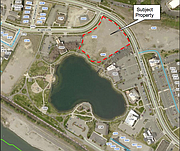Large-scale projects receive approval
A 63-foot-high apartment complex planned along the pond at Riverstone drew a slew of comments at a Tuesday public hearing before the Coeur d’Alene planning commission approved it.
The Riverstone proposal was one of two large-scale projects, each requiring special use permits for density increases, that planning commissioners endorsed during their first meeting of the month in the Community Room of the Coeur d’Alene Public Library.
The commission also approved, by unanimous vote, a plan for a 43-unit multifamily complex along Government Way south of Ironwood Drive. The development would front the west side of Government Way on 1.3 acres between west Mill and west Davidson avenues, and calls for a tiered, four-story building with a parking lot on the west side and commercial property on the ground floor.
Mike Walker of Miller Stauffer architects, who presented the proposal, said the project meets the criteria for an R34 zoning — an increase from its C17 designation — because of its proximity to shopping centers, parks, schools and a major arterial.
Neighbors gave the project mixed reviews,
Eric Swanbeck said he moved to Coeur d’Alene 15 years ago for the city’s ambiance, and has since seen the growth bulging in all parts of town. In his neighborhood a block away he feels the pressure of the surrounding growth.
“We’re a community that advertises the beauty of the scenery and yet we keep building big buildings and ruining the view of the mountains and lakes,” Swanbeck said. “Since I have been there I feel like I’m getting squeezed out from all sides; the hospital is coming one way, this project is coming from the other way, there are duplexes coming in every empty lot and I just feel like I’m being squeezed out, and that neighborhood is getting squeezed out.”
The most criticism, however, came after Ryan Nipp of Parkwood Business Properties presented the proposal to increase density to R34 for the five-story, 70,000-square-foot apartment complex that would accommodate 65 units on the Riverstone Pond. The building comprised of mostly one- and two-bedroom apartments averaging 800 square feet, Nipp said, was the most feasible for the site and wouldn’t greatly increase traffic in part, because it would target seasonal residents.
“It’s probably not as much family-oriented, as retirees,” Nipp said. “It’s probably not going to have a lot of families in there.”
Mary Jo Kringas, who lives in Riverstone, called the Parkwood structure a behemoth that would obstruct views, while neighboring buildings maintain a lower profile.
“The other commercial properties along there have been very ethical in terms of limiting their height,” Kringas said. “I’m concerned about the traffic impact but mostly I’m concerned about the view.”
If the proposed building lost a couple stories, Kringas said, “I think it would be a beautiful addition to the area, but as a five-story building I think it’s too tall.”
Kringas accused the planning commission of rubber stamping projects.
“I’m not feeling confident there is a lot of due diligence applied to what’s going on here,” Kringas said. “In my opinion if you want to deviate from the zoning you have to put forth a really good idea and a darn good reason … this building is huge, and I think that deserves consideration.”
Commissioners individually addressed public concerns, but agreed by a 4-1 vote that Riverstone is the most likely fit for an R34 zoning.
Commission member Lynn Fleming, the only no vote on the Parkwood project, said the building would obliterate the view of the pond and the mountains across the Spokane River. She wanted parts of the building lowered to maintain at least a partial view of the surrounding countryside.
Vice chair Jon Ingalls, addressing the criticism of both projects, said it was unrealistic for newcomers to the area to think that growth in Coeur d’Alene should remain stagnant. The longtime resident said he learned to drive on Coeur d’Alene’s streets in 1973 when there were 15 stoplights in town, and although the old city is fondly missed, dwelling on its past is not realistic.
“Sure sometimes I reminisce and reflect on what that might be like and how cool that little town was,” Ingalls said. “I think growth and vibrancy and keeping this town alive go hand in hand.”
Ingalls said he had no intention of joining a mindset that called for a moratorium on growth.
“I’m going to go on the record and say that while 1973 Coeur d’Alene was a little bit easier to get around, in a lot of ways the 2019 Coeur d’Alene is a lot better Coeur d’Alene,” Ingalls said. “I think what we should be looking for is quality projects, and this one has a number of great features.”



